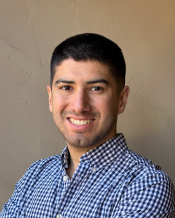Lizard-loving ASU graduate seeks to understand what drives evolutionary patterns

Raúl Araya-Donoso doing field work in the Sonoran desert. Courtesy photo.
Editor’s note: This story is part of a series of profiles of notable fall 2024 graduates.
Over the billions of years that the Earth has existed, millions of different weird and wonderful creatures have evolved.
Raúl Araya-Donoso, a fall 2024 graduate of the evolutionary biology PhD program at Arizona State University, has always been fascinated with how they came to exist.
“What was always striking to me is how there are so many different life forms in nature, and how they seem to be so well adapted to the conditions they live in. So that’s why I like evolution, because it gives me some kind of explanation or mechanism to understand how so many different things exist,” he said.
Araya-Donoso studies evolution within different groups of lizards, a group he chose to focus on because their speciation patterns are especially unique. Some groups of lizards are highly diverse, containing hundreds of species, while other groups have just one species.
Admittedly, Araya-Donoso is also just a lizard fan: “I like the tiny lizards. They’re just so cute.”
Motivations aside, Araya-Donoso spent his PhD comparing the genomes of lizards from different groups to try and assess whether the genomes in some groups are more dynamic, or might evolve more easily, than the genomes in other lizards’ groups. He also tried to understand what kinds of factors determine how lizards evolve.
“What I found is that everything matters — both extrinsic factors like selection pressure of the physical isolation between populations, but also intrinsic factors like their behavior, ecology and their genetics. The challenge for me now is to know the relative relevance of these different factors. But I have my whole life to study that,” he said.
Araya-Donoso first became fascinated with lizards at the University of Chile, where he was mentored by Professor Madeleine Lamborot, a cytogeneticist who researched lizard chromosomes.
“I wasn’t sure what I was going to do after undergrad. But when I started doing research, I loved it so much that I couldn’t stop … Dr. Lamborot made me fall in love with genetics and want to know more about how everything is coded in the genome and how we can get so much information from genetic data.”
Araya-Donoso became so enamored with the research that he pursued a master’s degree to keep studying lizard evolution. After feeling like he had learned from some of the most qualified people in Chile, he decided to pursue his PhD abroad.
With the Agencia Nacional de Investigación y Desarolla (ANID) award from the Chilean National Research and Development Agency, he was able to pursue his PhD at ASU with Kenro Kusumi and Greer Dolby. Over the years, he has spent weeks camping in remote deserts catching lizards in Baja, California, participated in the Dance Your PhD contest, and, of course, spent hours poring over lizard genomes on Tempe campus.
Next, he’ll be moving to Yale University to continue his research as a post-doctoral researcher.
Question: Which professor taught you the most important lesson while at ASU?
Answer: Kenro is amazing. We are very different. Kenro is very practical, and he has really helped me to ground myself in reality. I’m very ambitious, and I would like to do all this science. But Kenro has always been like, “OK. But you need to graduate.” That really helped me. I hope I learned something from him about being better organized, and how to plan. So he’s definitely impacted me and the way I do things.
Q: What are your plans after graduating?
A: I’m very passionate about my research question, so I think I wanna get closer to an answer. I will start my post-doc in March, and I will be tackling some of the same questions. I want to follow an academic career to keep trying to answer this.
In the long term, I really want to go back home. It’s an amazing opportunity to be here in the U.S.; we have amazing people. So, I want to stay for a while and learn as much as I can. One day, I really want to mentor students, let them have their own projects and help them flourish. I think that’s one of the things I would like to do most when I go back home.
Q: What advice do you have for those who are still in school?
A: Maybe everyone says this, but try to survive. Do your best to stay healthy. Try to find your passion, whatever it is, and stick to that like. Because if you’re doing something you’re passionate about, even the bad days won’t be that bad. That will help you survive, because what we do is super challenging and stressful. So we need to have a source of joy from it.
More Sun Devil community
Hundreds of new Watts College alums celebrate during fall ceremony
Hundreds of new graduates celebrated their first day as Arizona State University alumni Dec. 17 at the Watts College of Public Service and Community Solutions fall 2024 convocation ceremony…

Passion for human behavior drives first-gen student to major in psychology
Editor’s note: This story is part of a series of profiles of notable fall 2024 graduates.Natalie Motta is a driven and accomplished young woman who embodies resilience, ambition and a…

ASU grad turns interest in true-crime podcasts into passion for forensic psychology
Editor’s note: This story is part of a series of profiles of notable fall 2024 graduates.Kymberlin Quackenbush exemplifies resilience and ambition as she prepares to graduate from ASU’s New…
